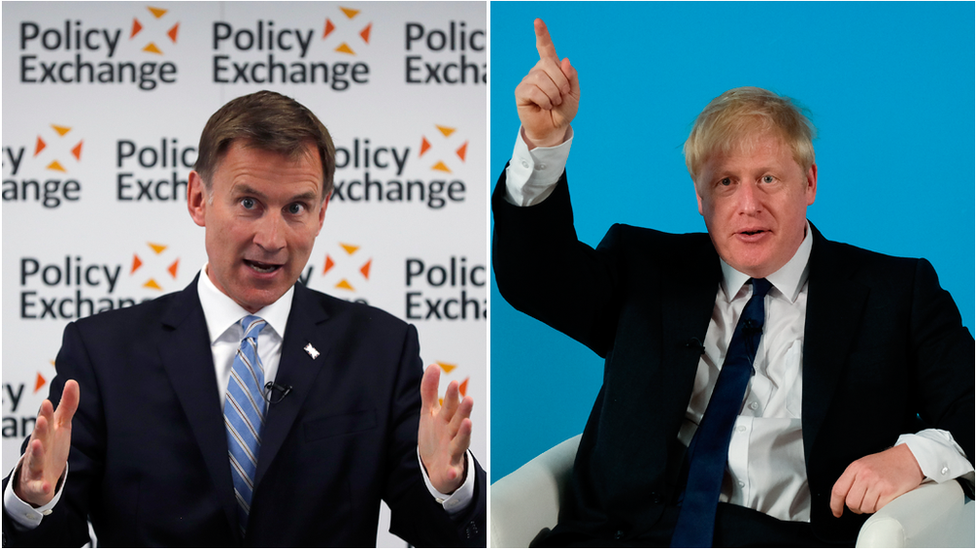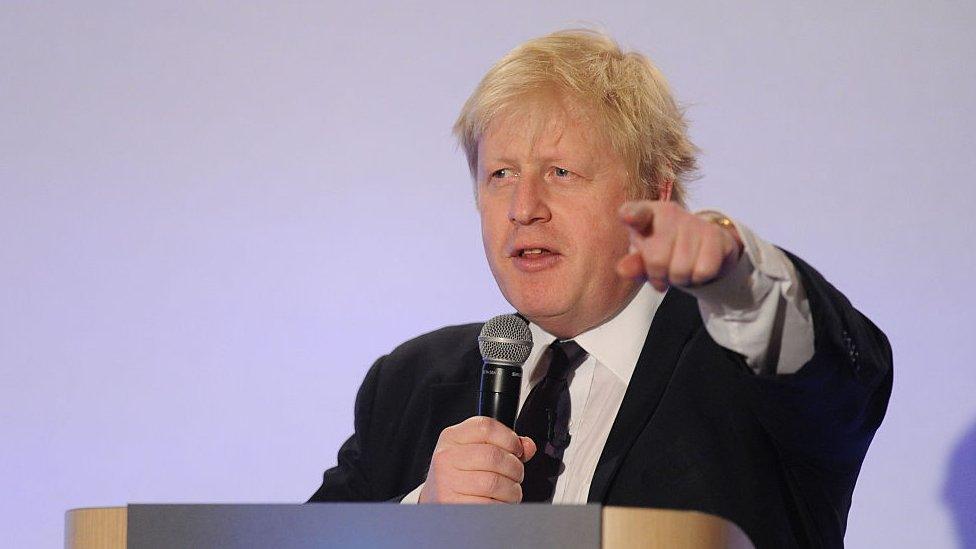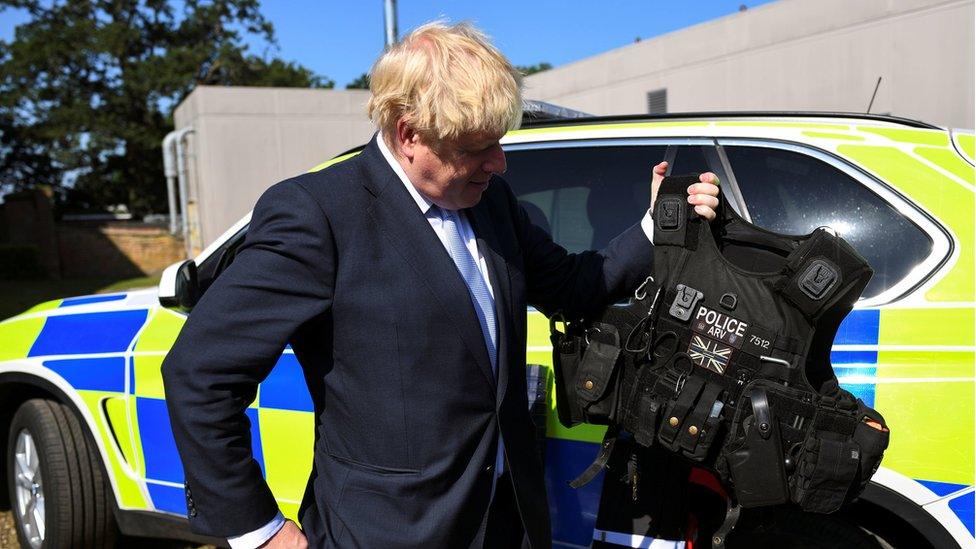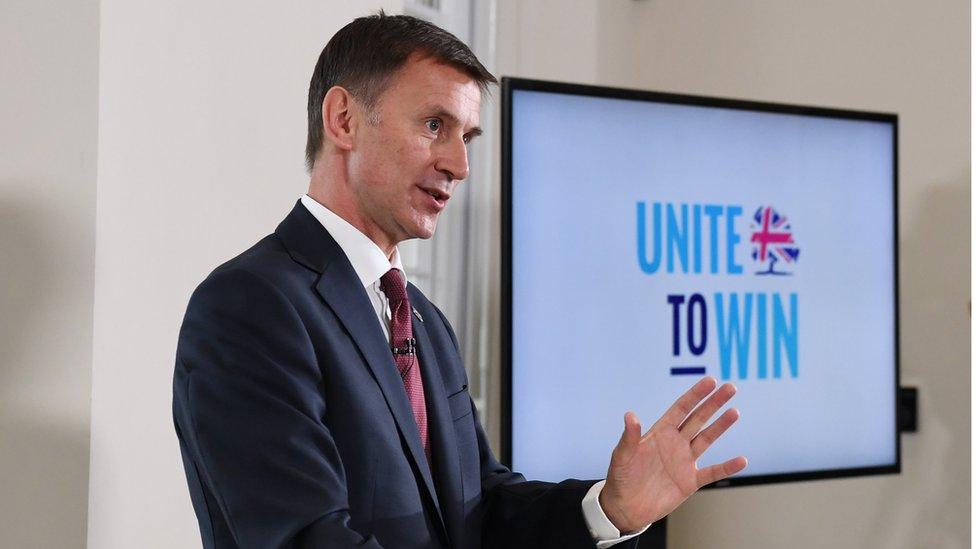Tory leadership contest: Do tax plans add up?
- Published

In the race to succeed Theresa May as leader of the Conservative party and prime minister, Boris Johnson and Jeremy Hunt are setting out how they want to run the UK.
They have both announced taxation and spending plans. So, what are the details and do their sums add up?
Boris Johnson

People would only start to pay the higher rate of income tax when they earn at least £80,000, under Boris Johnson's plans
The plan: Raise the higher income tax rate from £50,000 to £80,000.
What it means: At the moment, individuals have to pay 40% income tax on any earnings above £50,000, external. So, a person earning £55,000 a year, pays 40% on £5,000.
Under Mr Johnson's plan, the point at which the 40% higher rate kicks in would be raised to £80,000. This would not affect Scottish workers because the Scottish government sets its own income tax rates and bands.
Mr Johnson also wants to raise the point at which people start paying National Insurance, absorbing some of the cost by also raising the ceiling for NI.
National Insurance is a separate tax. It's paid for by workers and companies and it is meant to fund state benefits, such as the NHS.
Under this new tax regime, someone earning £60,000 a year could benefit by £1,000 a year, while someone on £80,000 or more would gain a maximum of £3,000 (because some of the benefits would be lost due to national insurance increases).
But it's wealthy pensioners who stand to benefit the most - up to £6,000 each, according to analysis from the Institute for Fiscal Studies (IFS). That's because pensioners don't pay national insurance to begin with.
So if someone already receives a generous work pension, not only will they be subject to less income tax (up to the new threshold), they also won't be affected by the national insurance rise.
The cost: Changing the tax system in this way would cost around £10bn a year, according to Mr Johnson. He says the bill could be funded from the £26.6bn of "fiscal headroom".
This "headroom" refers to government borrowing, which came in lower than originally expected and had been ear-marked by the chancellor for no-deal Brexit planning.
However, if Mr Johnson chooses to fund his tax changes with this £26.6bn, it would not amount to a permanent solution. That's because the money can only be spent once.
So, to pay for the policy in the long term, Mr Johnson will need to raise taxes elsewhere, announce spending cuts or continue to fund it from government borrowing.

The plan: Raise public sector pay and increase school funding
What it means: A leading supporter of Mr Johnson, Health Secretary Matt Hancock, told the Times that the days of public sector pay freezes under Theresa May and David Cameron would be over if Mr Johnson was elected.
Public sector pay was frozen for two years in 2010, except for those earning less than £21,000 a year, and rises were capped at 1% in 2013. The government announced an end to the pay cap in 2017, and some public sector workers have negotiated increases above 1% since then.
The candidate himself has declined to specify by how much he would increase pay, saying only that remuneration should be "decent".
He has also pledged to fund increased investment in special needs education, as part of a £4.6bn boost to overall school funding.
The cost: We don't know by how much Mr Johnson wants to increase public sector pay, but the IFS says, external that each 1% increase in pay for the public sector workforce costs the government about £1.8bn a year.


The plan: Hire an extra 20,000 police officers by 2022
What it means: There are 122,000 police officers in England and Wales, down from 143,000 in 2010 when Theresa May became home secretary.
Mr Johnson plans to reverse almost all of those cuts on the basis that "more people on our streets means more people are kept safe".
There has been some dispute about the link between police numbers and levels of violent crime, with Theresa May saying there was not a direct link.
But Metropolitan Police Commissioner Cressida Dick has said there is "some link" between the two.
The cost: Mr Johnson gave a figure of £1.1bn.
For police officers outside London, the lowest pay, external was around £25,400 in 2016 (although this differs from force to force).
That comes to £500m a year, but these costs will increase once they complete training, which takes around two years.
Typically, after four years, the pay would increase to £33,700 (again outside London) - so almost £700m, but this doesn't account for training costs.
The Nottinghamshire police force , externalestimated recruitment and training to be around £13,000 per officer in 2012 (not including salary received during training).
This would come in at about £258m for 20,000 new officers, but again, this will differ from force to force.
Kit Malthouse, who supports Mr Johnson, says that they would recruit special constables, who are trained as police officers but work part time, to help alleviate training costs.

Jeremy Hunt

The plan: Cut corporation tax to 12.5%
What it means: From April 2020, instead of paying 17% tax on their profits, companies would pay 12.5%.
The foreign secretary is in favour of cutting the rate of corporation tax - the tax that companies pay on their profits - to 12.5%, which is the same rate as in the Republic of Ireland.
The government is already planning a series of cuts to corporation tax, which was cut from 20% to 19% on 1 April 2017, and is scheduled to fall to 17% next year.
The idea of cutting it by another 4.5 percentage points came in a report, external by another Conservative MP at the end of May.
The cost: The government estimates the policy would cost about £14bn a year. That cost would be reduced if future tax takes were to be boosted by companies being attracted to move to the UK to take advantage of the lower tax rate, or if companies use the money saved to pay higher wages or invest it in improving their productivity.
How much that would reduce the cost is very hard to predict.

The plan: Take 90% of businesses out of business rates
What it means: Business rates are a local tax paid on the use of buildings for non-domestic purposes.
The cost: We haven't seen any formal costings of this policy, but in the 2018 Budget, Philip Hammond decided to give a one-third discount on business rates to high street retail businesses with a rateable value below £51,000 in 2019-20 and 2020-21. The Treasury said that would benefit 90% of high street retail businesses.
The Office for Budget Responsibility said, external the discount would cost £490m this year and £450m next year.
It means we can estimate that a 100% cut for those businesses would cost an extra £900m next year and about £1.35bn a year after that.
Business rates are currently collected by local authorities, which retain half of the money. Central government is reimbursing them for the one-third cut and would presumably also reimburse them for the 100% cut.

The plan: Increase annual investment allowance to £5m
What it means: If you are running a business and you buy equipment such as computers or machinery, you can deduct the amount you spend on it from your profits to reduce the amount of tax you have to pay.
There is a limit, external to the amount you can deduct, which is called the annual investment allowance. At the start of this year it was raised from £200,000 to £1m for two years.
The cost: We do not have a costing for this measure either, but to get an idea of the amounts of money involved, the OBR said, external the temporary increase to £1m would cost £600m this year.

The plan: Money for fishing, farming and defence
What it means: Jeremy Hunt would increase spending on defence from its current level of 2% of Gross Domestic Product (GDP - the sum of everything the UK produces each year) to 2.5% of GDP by 2023-4.
He has also said he would have a "relief programme" for the fishing and farming sectors to help them deal with the effects of a possible no-deal Brexit.
The cost: The boost to defence spending would cost £15bn a year by 2023-4. The relief for fishing and farming would cost £6bn. Mr Hunt says his overall plans would "kick-start the economy and create extra growth", which would mean the government had extra money to spend.
But the disruption involved in leaving the EU with no deal is widely expected to reduce growth - at least initially - which would mean that increased taxes or borrowing or reduced spending in other areas would be required to fund the extra spending.

